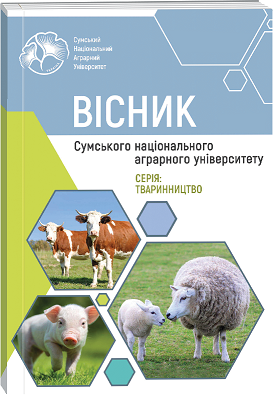INFLUENCE OF BETA-CASEIN GENOTYPE ON MILK QUALITY INDICATORS IN BROWN CATTLE
Abstract
In breeding herds of Lebedinian and Ukrainian brown dairy breeds, studies were conducted to study the polymorphism of the beta-casein gene and its effect on the quality of cow's milk. Genotyping of 242 head of cattle of the above breeds was carried out. Determination of beta-casein gene polymorphism was performed in the genetic laboratory of the Bogomoletz Institute of Physiology. The TagMan@Genotyping system and a set of primers and probes were used for allelic discrimination. It was found that the fre-quencies of alleles A1 (0.308-0.313) and A2 (0.687-0.692) in the locus of the beta-casein gene in animals of different breeds dif-fered. The population of Lebedinian cows had the highest frequency of the desired A2 allele (0.692), and the Ukrainian brown dairy population had the lowest frequency (0.687). The frequency of the A1 allele was the lowest in cows of Lebedinian breed (0.308) and the highest - in cows of Ukrainian brown dairy breed (0.313). Accordingly, the frequencies of genotypes A1A1, A1A2 and A2A2 dif-fered depending on the origin. The desired genotype was more common in animals of Lebedinian breed (51%). Heterozygous geno-type was more characteristic of animals of the Ukrainian brown dairy breed (45%). The highest frequency of the A1A1 genotype was characterized by Lebedinian animals (13%). According to genetic and statistical analysis, an excess of homozygous variants of A1A1 and A2A2 in the beta-casein locus was found. Heterozygous A1A2 deficiency was found in animals of Lebedinian breed. There was a difference in the quality of milk between animals of different genotypes. In animals of different breeds, the content of individual components of milk did not vary equally depending on the genotype of beta-casein, but this difference was statistically insignificant. In terms of fat and protein content in milk, animals of all genotypes met the breed standard. Thus, it can be stated that the formation of herds with the A2A2 genotype for beta-casein will not have a negative impact on the productive traits of cows and thus ensure the preservation of high quality of milk of cattle herds of a new type. The small number of experimental animals, in our opinion, was one of the reasons for the lack of a significant difference between the average values of the milk components of cows of different geno-types for beta-casein.
References
Givensa I., Aikmana P., Gibsonb T., Browna R. Proportions of A1, A2, B and C β-casein protein variants in retail milk in the UK. Food Chemistry. 2013. Vol. 139, P. 549-552.
Fuerer C., Jenni R., Cardinaux L., Andetsion F., Wagnire S., Moulin J., Affolter M. Protein fingerprinting and quantification of β-casein variants by ultra-performance liquid chromatography–high-resolution mass spectrometry J. Dairy Sci. 2019. Vol. 103, P.1193–1207 https://doi.10.3168/jds.2019-16273.
Kaskous S. A1- and A2-Milk and Their Effect on Human Health. Journal of Food Engineering and Technology. 2020. Vol. 9(1), P.15-21.
O'Callaghan T. An overview of the A1/A2 milk hypothesis. Dairy Nutrition forum. 2020. Vol. 12, issue 2. P. 1-4.
Bentivoglio D., Finco A., Bucci G., Staffolani G. Is There a Promising Market for the A2 Milk? Analysis of Italian Consumer Preferences Sustainability 2020. Vol. 12. P. 2-16. https://doi:10.3390/su12176763
Xiaoyang S., Zailing Li, zJiayi Ni, Yelland G. Effects of Conventional Milk Versus Milk Containing Only A2 b-Casein on Digestion in Chinese Children: A RandomizedStudy. JPGN Vol. 69 (3). P. 375-382. https://doi.10.1097/MPG.0000000000002437.
Guantario B, Giribaldi M., Devirgiliis C., Finamore A., Colombino E., Capucchio M., Evangelista R, Motta V., Zinno P., Cirrincione S., Antoniazzi S., Cavallarin L., Roselli M. A Comprehensive Evaluation of the Impact of Bovine Milk Containing Different Beta-Casein Profiles on Gut Health of Ageing Mice. Nutrients. 2020, Vol. 12. P. 21-47. doi:10.3390/nu12072147.
Italo Mencarini. A simulation model of dairy herd cjnversion to produce A2 milk. Abstract of a thesis submitted in partial fulfillment of the requirements for the Degree of Master of Agricultural Science. Lincoln University Digital Thesis. 2013. 51 p.
Amalfitano N., Cipolat-Gotet C., Cecchinato A., Malacarne M., Summer A., Bittante G. Milk protein fractions strongly affect the patterns of coagulation, curd firming, and syneresis. J. Dairy Sci. 2018. Vol. 102, P.2903–2917. DOI: https://doi.org/10.3168/jds.2018-15524
Henrique do Nascimento Rangel A., Cavalcanti Sales D., Antas Urbano S., Geraldo Bezerra Galvãojúnior J., César de Andrade Neto J., de Souza Macêdo C. Lactose intolerance and cow’s milk protein allergy. Food Science and Technology. 2016. Vol. 36(2), P. 179-187. http://dx.doi.org/http://dx.doi.org/10.1590/1678-457X.0019.
Parashar A., Saini R. A1 milk and its controversyareview. International Journal of Bioassays. 2015. Vol. 4. №12, P. 4611-4619.
Кононова Л.В., Сычова О.В., Омарова Р.С. Необыкновенное коровье молоко. Молочная река. 2016. №3(63), С.62-64.
Кузьменко Н.Б., Кузина А.Н. Роль β-казеина в питании детей первых лет жизни. Лечащий врач. 2016. № 01/16, С.75-80.
Gustavsson F., Buitenhuis A., Johansson M., Bertelsen H., Glantz M., Poulsen N. Effects of breed and casein genetic variants on protein profile in milk from Swedish Red, Danish Holstein, and Danish Jersey cows. J. Dairy Sci. 2013. Vol. 97, P.3866–3877. DOI: http://dx.doi.org/ 10.3168/jds.2013-7312
Kostyunina, O. V., 2005. Molekulyarnaya diagnstika geneticheskogo polimorfizma osnovny`kh molochny`kh belkov i ikh svyaz` s tekhnologicheskimi svojstvami moloka. Abstractof Ph. D. dissertation. Dubroviczy.
Miluchová, M., Gábor, M., Candrák, J., Trakovická, A., Candráková, K., 2018. Association of HindIII-polymorphism in kappa-casein gene with milk, fat and protein yield in holstein cattle. Acta Biochimica Polonica. issue 65, No 3, pp. 403–407.
Селионова, М. И., Чижова, Л. Н., Суржикова, Е. С., Шарко Г.Н., Михайленко, Т. Н., Чудновец, А. И. Породные особенности аллельного профиля генов, контролирующих молочную продуктивность крупного рогатого скота. Агрозоотехника., 2019. №2 (1). С. 1-12. DOI: https: // 10.15838/alt.2019.2.1.3
Ladyka,V., Pavlenko, Y., Sklyarenko, Y. β-casein gene polymorphism use in terms of brown dairy cattle preservation. Archivos de Zootecniaal. 2021, Vol. 70 (269). P.88-94. DOI: https://doi.org/10.21071/az.v70i269.5422
Ладика В.І., Скляренко Ю.І., Павленко Ю.М. Характеристика генетичної структури за геном β-казеїну плідників, допущених до використання в Україні у 2020 році. Технологія виробництва і переробки продукції тваринництва. 2020, Вип. 1 (156). С. 38-46.

 ISSN
ISSN  ISSN
ISSN 


